Procurement Risk Management: What You Need to Know


It’s undeniable: when purchasing from suppliers, often scattered worldwide, risks are your ever-present companions.
Questions arise: are your suppliers financially secure? What threats loom that could disrupt timely delivery and quality?
And let’s not forget the risks of geopolitical tensions and supply chain surprises. Even internally, there is a risk of fraud or operational inefficiency.
To put it simply, risks, multifaceted and stealthy, lurk in every corner of procurement.
However, you can prevent some of them and be prepared to handle the rest.
How? Through procurement risk management.
Today, we will tell you everything you need to know about it to manage your procurement risks better and thus safeguard your organization from these threats.
Let’s begin by defining risk management.
Procurement professionals like yourself are well aware that securing top-quality products or services at the right price and time is no easy task.
And, in this pursuit, risks abound.
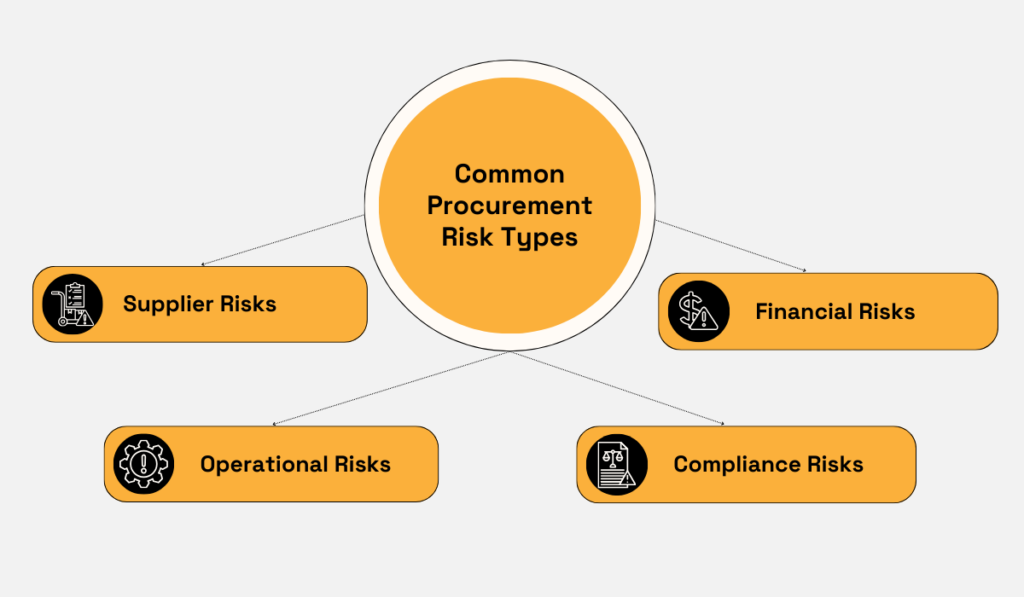
Source: Veridion
Supplier risks, for instance, are significant, ranging from production delays and quality issues to financial instability and compliance concerns.
Operational hazards, such as equipment failures or staffing shortages, can also disrupt your plans.
Additionally, the threat of fraud, data security breaches, cyberattacks, and external factors like natural disasters or regulatory changes further complicate matters.
Financial risks, including fluctuations in raw material prices and currency exchange rates, also pose challenges.
However, procurement risk management is your guide through these challenges.
So, what does it involve?
In essence, risk management in procurement encompasses three main steps: identifying, assessing, and mitigating risks.
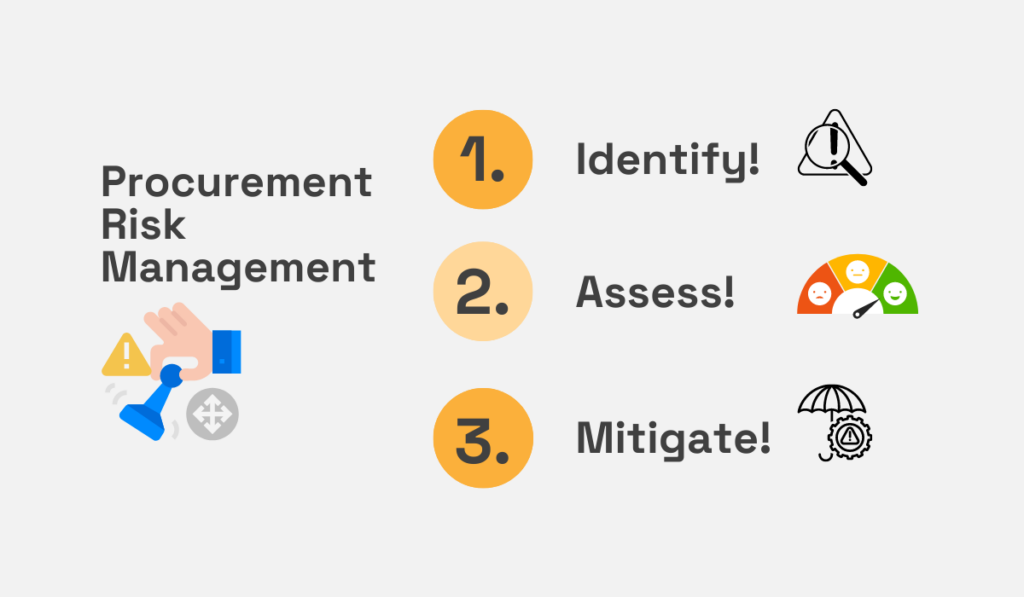
Source: Veridion
Firstly, identifying risks entails recognizing all potential threats to your procurement process.
These risks could vary in nature and impact: from supplier-related issues to operational challenges and external factors.
Next, assessing risks involves evaluating each identified risk based on its potential impact and likelihood of occurrence.
This step helps prioritize which risks require immediate attention and which can be managed over time.
Finally, mitigating risks entails developing and implementing strategies to reduce or eliminate their impact.
This could involve:
But, of course, the process doesn’t end there.
Continuous monitoring and control are crucial aspects of procurement risk management.
This involves regularly reviewing your procurement activities and the overall market and supply chains for any changes that could affect identified risks.
Adjusting risk management strategies accordingly ensures that your organization remains resilient despite evolving threats.
So, as a procurement expert, your role in procurement risk management is vital—and it never stops.
You are responsible for:
Overall, the goal of procurement risk management is to minimize disruptions and ensure continuity in operations by identifying risks, implementing effective mitigation strategies, and building resilience within the organization.
Why all of this matters, we will explain in the next few sections.
By effectively managing procurement risks, you ensure timely access to high-quality products and services at optimal prices.
Alongside this, you safeguard your finances, minimize operational disruptions, uphold your reputation, and cultivate robust supplier relationships.
All of this makes risk management a crucial factor in your procurement.
Let’s examine each of these benefits in detail.
All of the procurement risks, in one way or another, lead to more spending than you initially planned for.
For instance, if suppliers fail to deliver products or services on time, you may incur additional expenses to expedite delivery or find alternative suppliers, resulting in higher costs than budgeted for.
Similarly, quality issues with delivered goods or services may need rework or replacement, further adding to expenses.
Fluctuations in raw material prices or currency exchange rates can impact procurement costs, potentially exceeding budgeted amounts if not properly managed.
Additionally, the risk of fraud poses a significant threat to your organization’s financial health, with the majority of companies reporting annual losses ranging from $10,000 to $150,000.
And not to mention all of the current supply chain disruptions and related risks, as aptly laid out in Interos’ annual supply chain survey:

Source: Interos
As per the survey, the annual financial impact of these disruptions, in terms of lost revenue and additional costs, ranges from $43 million to $47 million.
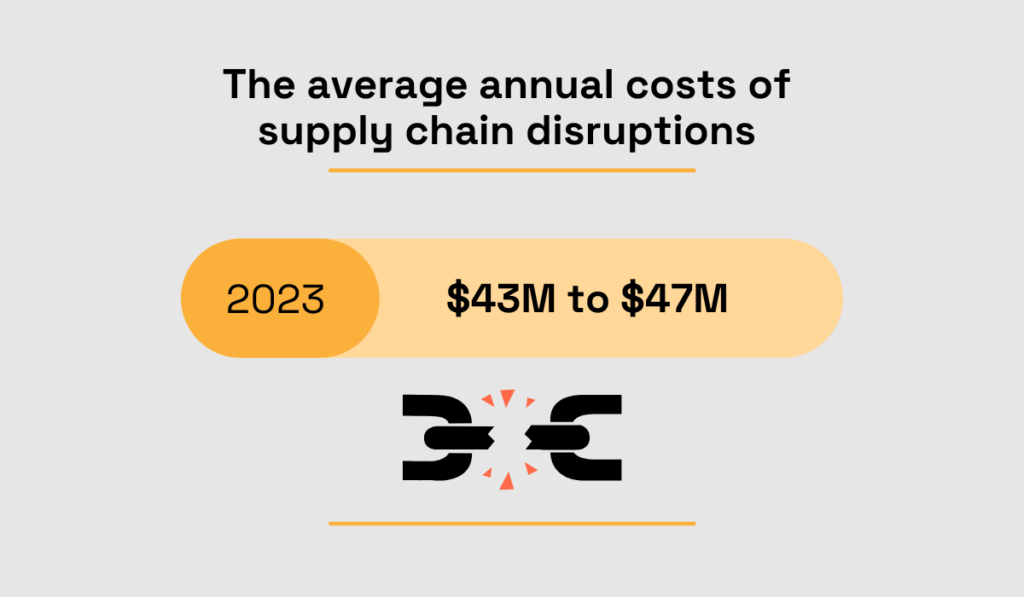
Illustration: Veridion / Data: Interos
However, the same research reveals that being better prepared and able to react faster to supply chain disruptions can save organizations an average of $37 million annually.
In other words, by identifying these risks in time and putting policies in place to prevent or mitigate them early in the procurement process, you can avoid unexpected expenses and maintain control over costs.
For instance, implementing supplier performance monitoring systems, diversifying your supplier base, negotiating comprehensive contractual agreements, and regularly auditing procurement processes are all ways to mitigate procurement risks.
This ensures that your organization can allocate resources efficiently and avoid financial setbacks that could impact its overall financial health and sustainability.
Procurement risk management is like having a safety net in place when you’re handling purchases for your company.
It helps you anticipate and address potential issues before they disrupt your operations.
For instance, if a supplier cannot deliver goods on time, your procurement risk management strategy would kick in.
You might have backup suppliers lined up, or you could negotiate expedited shipping to ensure minimal disruption to your production schedule.
Similarly, if there are disruptions in transportation, such as port closures or strikes, your risk management plan would include protocols for finding alternative routes or modes of transport to maintain the timely delivery of goods.
In essence, procurement risk management is about proactively identifying and mitigating risks to keep your procurement processes running smoothly and your business operations uninterrupted.
And this holds even more weight in the face of supply chain disruptions.
Take, for instance, AGCO Corporation, a prominent agricultural machinery manufacturer operating globally.
During the COVID-19 pandemic, AGCO utilized robust procurement risk management strategies and tools to navigate the challenges.
One of the tools was a risk notification and visualization solution, which provides a graphical view of AGCO’s supply chain across multiple supplier tiers.

Source: Sphera
The tool continuously monitors various risks, drawing from online and social media sources, and illustrates the flow of components to different factories and nodes in the supply chain.
When a supplier’s material flow becomes questionable, the tool automatically notifies the appropriate commodity managers.
So, during the COVID-19 pandemic, this tool became critical in predicting disruptions.
AGCO was able to foresee the shutdown of South Korean operations days in advance and expedite shipments from affected suppliers before plant closures.
As a result, impacted suppliers’ plants were able to resume operations and ensure operational continuity.
This example perfectly describes how vital procurement risk management is in maintaining operational resilience, particularly during times of crisis.
Procurement risk management plays a vital role in enhancing your organization’s reputation by demonstrating a commitment to reliability, integrity, and responsible procurement practices.
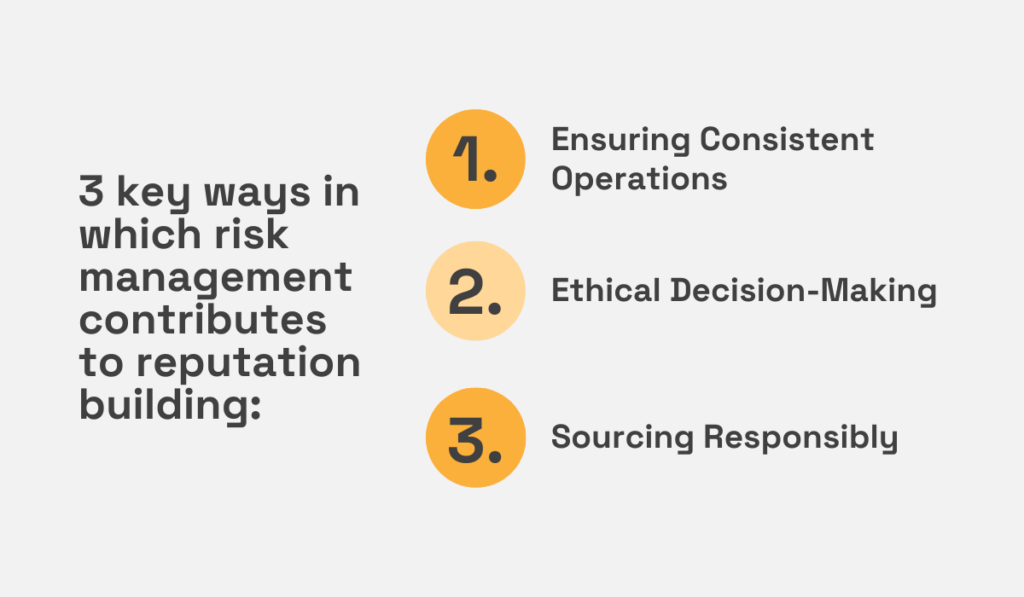
Source: Veridion
Here’s how.
First, by effectively managing risks, you ensure consistent and uninterrupted operations, which builds trust among stakeholders.
When your clients see that you can deliver products and services on time and without disruptions, they perceive your organization as reliable and dependable.
Procurement risk management also involves ethical decision-making and compliance with regulations and standards.
When you prioritize integrity in your procurement processes, you can establish a reputation for honesty and ethical conduct, which further strengthens trust with stakeholders.
Finally, managing risks proactively involves considering the environmental, societal, and economic impact of sourcing materials and goods.
By sourcing responsibly and sustainably, you demonstrate your commitment to social and environmental responsibility, which also enhances your organization’s reputation.
Overall, procurement risk management ensures that your organization operates with integrity, reliability, and responsibility, which are essential for building and maintaining a positive reputation in the marketplace.
Your procurement team is the bridge between your organization and its suppliers.
By effectively managing risks, you’re essentially reinforcing that bridge, making it stronger and more resilient to withstand any challenges that may arise.
Here’s how procurement risk management helps maintain healthy supplier relationships:
| Proactive Communication | By identifying and addressing potential risks early on, you can communicate openly with your suppliers. This fosters a culture of transparency and trust, where both parties feel comfortable discussing issues and finding solutions together. |
| Mutual Understanding | Effective risk management ensures that you and your suppliers clearly understand expectations and responsibilities. This helps prevent misunderstandings and conflicts down the line, as everyone is on the same page from the outset. |
| Long-term Partnership | When suppliers see that you’re committed to managing risks and investing in the relationship, they’re more likely to view you as a valued partner rather than just another customer. This lays the groundwork for long-term partnerships built on trust, respect, and mutual benefit. |
However, neglecting risk management can be detrimental when it comes to supplier relationships.
Let’s focus on the risk of fraud for a moment, as it can result in significant disruptions and strain your supplier partnerships.
Trustpair’s US Fraud Study from 2023 revealed that, for 39% of companies, fraud incidents generated supplier issues.
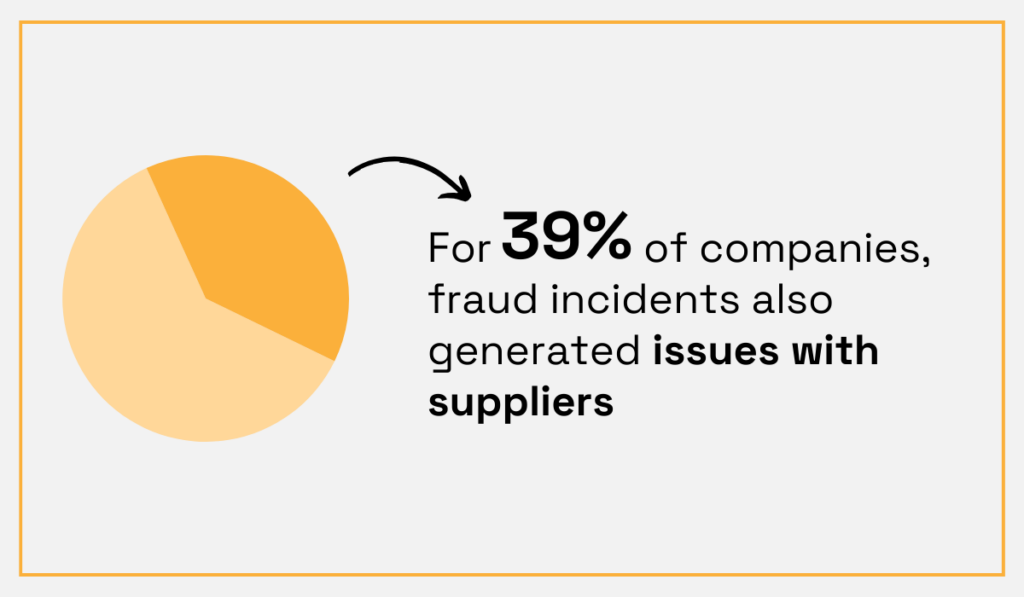
Illustration: Veridion / Data: Trustpair
This isn’t surprising when you consider a few key reasons:
So, how does procurement risk management fit the picture?
Procurement risk management includes measures to detect and prevent fraudulent activities, such as false invoicing or payment scams.
By implementing robust controls and monitoring mechanisms, you can reduce the risk of fraud within your procurement processes.
This protects your organization’s finances, safeguards your reputation, and strengthens trust with suppliers.
So, it’s more than evident that procurement risk management can impact the health of your supplier relationships, ultimately affecting the success of your organization.
Embracing innovation and leveraging new technology is crucial for successful risk management, as noted by one procurement leader from the Interos research we mentioned above:
“Successful risk management requires a change in approach and attitude. It needs to embrace innovation in procurement and enable new technology.”
The toolkit for managing procurement risks includes a variety of solutions, ranging from procurement automation tools to specific risk visualization tools and supplier databases.
Let’s start with procurement automation tools.
Picture this: in a manual workflow, tasks are often time-consuming and prone to errors, leading to inefficiencies in the procurement process, as well as operational risks.
Shockingly, despite the risks, 70% of companies still rely on manual validation procedures like human callbacks, which paradoxically contribute to fraud vulnerability.
However, procurement automation tools come to the rescue.
They can automate processes such as supplier sourcing, managing vendor relationships, creating contracts, tracking invoices, and processing payments.
By eliminating manual errors and streamlining workflows, these tools not only save time and enable efficient operations but also provide digital proof that can mitigate risks like fraud and corruption.
So, by embracing automation, organizations can significantly reduce their vulnerability to such risks.
What’s more—you can manage risks more efficiently by using automation tools.
One of them is our Veridion, a specialized tool tailored specifically to supplier risk management.
Veridion is a supplier sourcing enabler that empowers procurement teams to identify the most reliable suppliers by evaluating factors such as product specifications, certifications, ESG criteria, and compliance.
What sets Veridion apart is its real-time alerting system, which provides instant notifications about changes in supplier behaviors or circumstances.
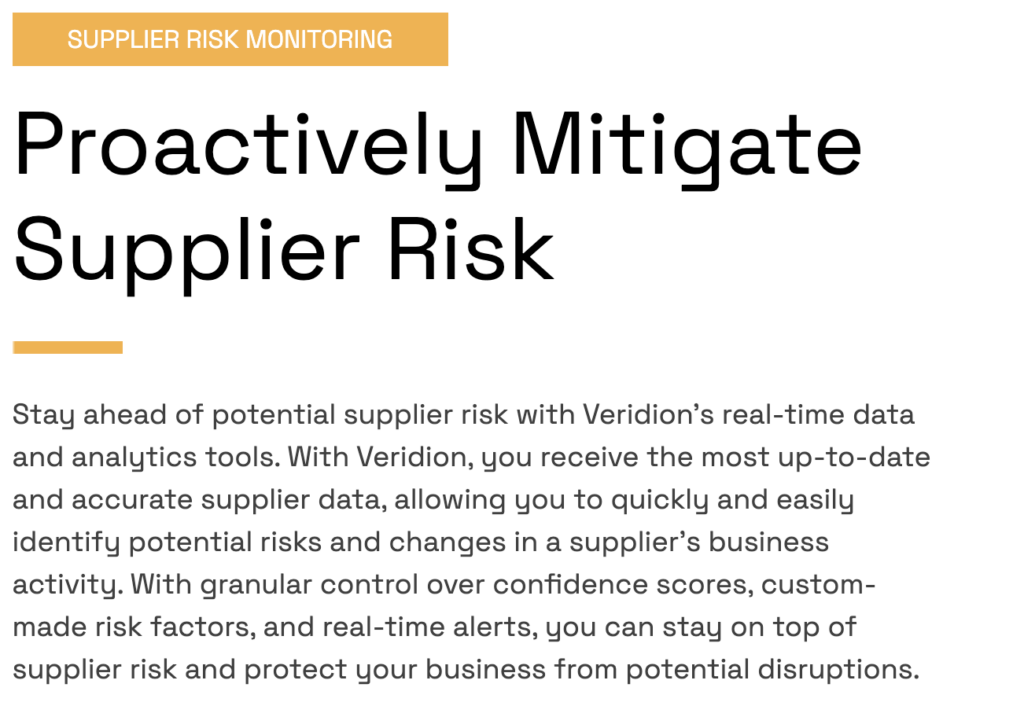
Source: Veridion
In other words, with Veridion, you can quickly respond to emerging risks and mitigate potential disruptions before they escalate.
Alongside these star players, a diverse team of tools stands ready to join the fight against procurement risks.
From risk visualization tools to supplier risk assessment software, contract management systems, and predictive analytics tools, each solution brings its unique strengths to the table, helping organizations proactively identify, assess, and mitigate risks at every turn.
In wrapping up, it’s clear that procurement risk management is a must-have for any organization.
Why? Because it’s all about safeguarding your financial health, reputation, and relationships with suppliers.
Think of it this way: by proactively identifying and addressing risks in your procurement processes—from suppliers to internal operations—you’re essentially fortifying your organization against potential threats.
Moreover, by nurturing healthy relationships with your suppliers through open communication and collaboration, you build trust and reliability within your supply chain.
This ensures smooth operations and enhances your organization’s reputation in the long run.
So, for your procurement team, managing risks shouldn’t be just another task.
Procurement risk management is a vital responsibility that directly affects the success and sustainability of your organization.